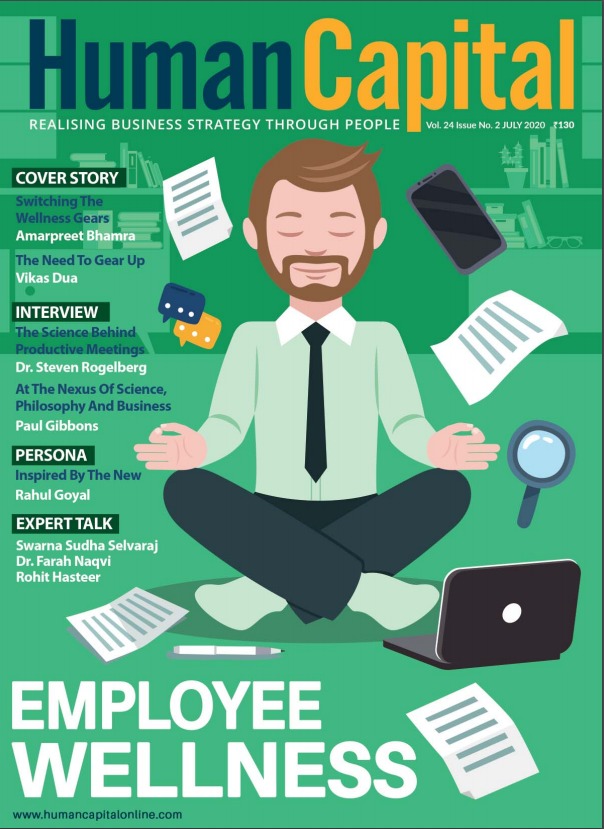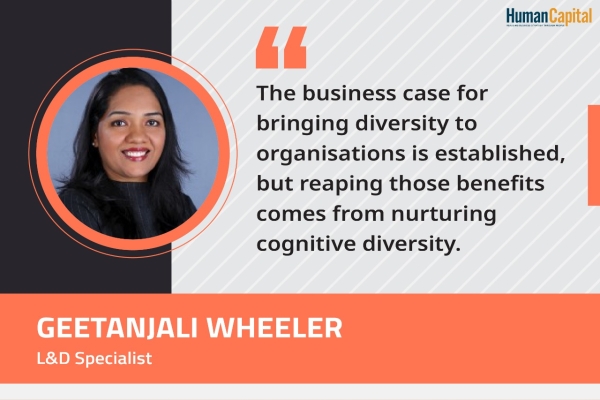
Organizational Intellect-Sharpening, Enriching, and Leveraging
An organization's intellect has two important characteristics: unlike physical assets, it increases exponentially with usage, and, increases most when shared. Organizations need to look outside, to span boundaries and forge links with professionals, professional institutions, and seats of higher learning such as universities to become aware of the latest trends and new developments that focus on the present and provide a pointer for the future.
It is clichéd to say that ours is a knowledge economy. It has also become axiomatic to assert that knowledge has become the most potent source of competitive advantage of firms today. Concepts such as knowledge management and organizational learning have become textbook stuff.
However, the full implication of the knowledge economy for organizations, and in particular,the usage of knowledge as a competitive asset is not well appreciated in professional discussions of HR managers.
The HR manager is rather preoccupied with questions of how to design the best workplace, maintain employee well-being and so on, and is left with little time to ponder on her roles in turning organizational knowledge to a competitive asset
Three processes of an organization's intellect
Intellect is defined as "The faculty of reasoning and understanding objectively, especially with regard to abstract matters". Harnessing knowledge depends on one's intellect. So what is organizational intellect?
In a very thought-provoking essay, Quinn, Anderson and Finkelstein explained that organizational intellect consists of four parts: knowledge of what, how, why, and self-motivated creativity. They further explained that an organization's intellect has two important characteristics: unlike physical assets, it increases exponentially with use, and it increases most when it is shared. We believe that to fruitfully use organizational intellect, three processes are necessary: sharpening, enriching, and leveraging.
Sharpening organizational intellect involves discovering existing knowledge within the organization, making the organization ready to absorb new knowledge from outside. For example, a software company needs to know it's available stock of knowledge, discover to what extent its members have knowledge of domains that are not of immediate (but potential) relevance to the organization, knowledge of emerging fields and trends in technology, exposing members to advanced techniques and the latest trends so that they are able to make sense of new technological developments in the field.
Enriching organizational intellect is facilitated when knowledge from diverse sources interact, leading to surprising and unique combinations. This requires new knowledge from external sources or from the various domains, existing within members in different verticals of the organization, interact with each other to suggest new insights, solutions to problems, or new advancements.
Leveraging organizational intellect requires the organization to recognize opportunities to apply existing knowledge or new knowledge to make existing products and processes better, or venture into new territories. An example might be to discover an employee with knowledge in a different domain and using that to launch a new product.
Three roles for HR managers
So what is the role of human resource managers vis-à-vis an organization's intellectual capability? Research over more than half a century in a wide variety of disciplines such as strategic management, organization studies, innovation management and the group behavior suggest three specific roles. Each of these roles target one of the above explained processes of sharpening, enriching, and leveraging.
I. Spanning roles
Organizations need to look outside, to span boundaries and forge links with professionals, professional institutions, and seats of higher learning such as universities to become aware of the latest trends and new developments that are not only directly relevant to the present operations of the organization, but more importantly, point to future directions. For most organizations, either this aspect is not well appreciated, or at best left to chance.
Ability, Intellect, and Intelligence
Ability
An individual’s capacity to perform the various tasks in a job.
Intellectual Ability
The capacity to do mental activities.
Multiple Intelligences
Intelligence contains four subparts: congnitive, social, emotional, and cultural
Recognition of boundaries
However, it is important to recognize that boundary spanning is the key to sharpening organizational intellect. The HR manager has an important, but very little appreciated, role in this. The HR manager is a natural fit for this role because as part of her development function, she is required to partner with trainers outside the organization, and organize developmental initiatives within.
Internal communication
Conversely, again by virtue of the HR manager's role, she is also required to communicate through the length and breadth of the organization, and is likely to be a key catalyst in reaching out to a cross-section of employees through developmental activities. Therefore, the HR manager is more likelyto encounter and discover knowledge and talent throughout the organization, as compared to the other managers who are confined within functional hierarchies.
In this sense, the HR manager is uniquely placed to span the silos in which a typically large organization is likely to be segregated. Taken together, external and internal boundary spanning by HR managers is likely to contribute to sharpening organizational intellect.
II. Pollinating roles
The second major role for the HR manager is with regard to enrichingorganizational intellect. It requires providing "discursive spaces" that facilitatediscourses - in the form of written or oral communication, including debates, discussions, usually on a serious subject.
Providing opportunities for interaction
They provide opportunities in which members are able to interact with each other, and discuss various problems and issues of common interest, not necessarily confined to organizational problems, obtain new insights, and thereby broaden their intellect. They can be physical, such as the coffee corner, cafeteria, the office corridor, or large events like conferences and seminars organized within the organization. Spaces can also be virtual, such as Facebook, Google Plus, or equivalent.
Making use of virtual space
The physical layout of office space, and opportunities for interaction in the virtual world, has been seen to impact the flow of communication. Therefore, an important role for the HR manager is to provide inputs on the design of such spaces. It can be argued from this that at one extreme, HR managers may even like to pitch in with their ideas when office spaces are being designed, and have dialogue with architects.
Besides, there are several other ways in which these roles can be enacted. In many organizations, such as Google, seminars are organized at regular intervals on a variety of topics that may not necessarily find immediate application within the organization. And cafeteria can be set up at strategic locations to ensure easy access from different parts of the office or factory.
III. Championing Roles
Finally, in order to leverage organizational intellect, opportunities need to be identified, nurtured and encouraged. In the technology management literature, it is widely recognized that product champions have an important role in whether a product idea eventually receives top management support and sees the light of day in the market. Similarly, the HR manager needs to recognize her role as idea champions. Because of her unique position within the organization, she is able to interact with a cross-section of members.
Picking up new ideas
She should, therefore, be sensitive to pick up new ideas in conversations. At the same time the HR manager is also likely to have more ready access to senior management. Hence new ideas that are discussed in various corners on a regular basis can be picked up and projected to senior management, with due credit and recognition to the initiators of the idea, so that proper encouragement and resources are extended to enable the originators to develop their ideas further.
In conclusion, we need to recognize that sharpening, enriching, and leveraging organizational intellect is of strategic importance today. Because this intellect is located within individual members, but taken together and aligned, become an organizational feature, the HR manager has a crucial, but so far little understood and underappreciated role.

Does your organisation support you in maintaining work-life boundaries?
Trending
-
SBI General Insurance Launches Digital Health Campaign
-
CredR Rolls Out 'Life Happens' Leave For Its Employees
-
Meesho Announces 30-Week Gender-Neutral Parental Leave Policy
-
Microsoft Unveils Tech Resilience Curriculum To Foster An Inclusive Future
-
60% Indian Professionals Looking For Job Change Due To COVID: Survey
-
SpringPeople And Siemens Collaborate For Digital Transformation Push
-
86% Professionals Believe Hybrid Work Is Essential For Work Life Balance: Report
-
Almost 1 In Every 3 People's Personal Life Affected Due To Work Stress
-
Meesho Rolls Out Reset And Recharge Policy For Employees
-
80% Of Talent Leaders & Academics Say Pandemic Changed Skill Needs For Youth: Report
-
Hero Electric Rolls Out 'Hero Care' Program For Employees
-
Human Capital In Collaboration With ASSOCHAM Hosts Virtual Conference
-
IKEA India, Tata STRIVE Collaborate To Create Employability And Entrepreneurship Opportunities
-
SAP India, Microsoft Launch Tech Skilling Program for Young Women
-
DXC Technology, NASSCOM Collaborate For Employability Skills Program
-
Lenskart To Hire Over 2000 Employees Across India By 2022
-
Mindtree Launches Learn-and-Earn Program
-
Tata AIA Extends 'Raksha Ka Teeka' To Its Employees
-
Swadesh Behera Is The New CPO Of Titan
-
NetConnect Global Plans To Recruit 5000 Tech Professionals In India
-
Hubhopper Plans To Hire 60% Of Indian Podcasters By 2022
-
Corporate India Needs More Women In Leadership Roles: Report
-
Aon to Invest $30 Million and Create 10,000 Apprenticeships by 2030
-
Tech Mahindra Launches ‘Gift a Career’ Initiative for Upskilling of Youth
-
40% Women Prefer Flexible Working Options in Post-COVID World: Survey
-
3 out of 4 companies believe they can effectively hire employees virtually: Report
-
Vodafone , CGI and NASSCOM Foundation launch digital skills platform
-
Odisha: Bank, postal employees to deliver cash for elderly, differently-abled persons
-
Skill India launches AI-based digital platform for "Skilled Workforce"
-
Hiring activity declines 6.73% in first quarter: Survey
-
70% startups impacted by COVID-19 pandemic
-
Bajaj Allianz Life ropes in Santanu Banerjee as CHRO
-
Over 70 Percent MSMEs look at cutting jobs to sustain businesses
-
93 Per Cent employees stressed about returning to office post-lockdown
-
Johnson & Johnson India announces family benefits for same gender partners
-
Indian firms turning friendly towards working mothers
-
Welspun India names Rajendra Mehta as new CHRO
-
Wipro partners with NASSCOM to launch Future Skills platform



Human Capital is niche media organisation for HR and Corporate. Our aim is to create an outstanding user experience for all our clients, readers, employers and employees through inspiring, industry-leading content pieces in the form of case studies, analysis, expert reports, authored articles and blogs. We cover topics such as talent acquisition, learning and development, diversity and inclusion, leadership, compensation, recruitment and many more.
Subscribe Now











































Comment